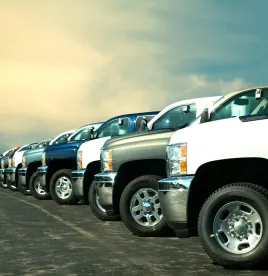On September 23rd, Governor Gavin Newsom issued a precedent-setting executive order cementing California’s continued effort to take the lead on clean vehicle policy. Executive Order N-79-20 establishes as a goal that, where feasible, all new passenger cars and trucks, as well as all drayage/cargo trucks and off-road vehicles and equipment, sold in California, will be zero-emission by 2035. The order sets a similar goal requiring that all medium and heavy-duty vehicles will be zero-emission by 2045 where feasible. These goals will be implemented by the California Air Resources Board (“CARB”) through regulations yet to be developed.
Governor Newsom’s executive order comes on the heels of the Advanced Clean Trucks Rule, issued by CARB in June. That rule requires that, beginning in 2024, a certain percentage of each truck manufacturer’s sales into California must be from zero-emission vehicles with a target that by 2045, all new trucks sold in California must be zero-emission. As noted in a prior update (link: here), that rule is currently being challenged by a coalition of manufacturers in state court. The executive order and CARB’s recently issued Advanced Clean Trucks Rule could significantly reshape all levels of the transportation industry. Together, the executive order and Advanced Clean Trucks Rule would almost certainly have the practical impact of limiting future sales of new vehicles in California to electric vehicles either powered by batteries or hydrogen fuel cells.
Implications for National Automotive Policy
While California is currently the only state to set specific goals for zero-emission passenger vehicles, medium and heavy-duty vehicles, and off-road vehicles and equipment, California’s plan could have impacts across the country. Other states are likely to follow California’s lead on this issue, and Section 177 of the Clean Air Act allows other states to adopt California’s regulations for vehicle emissions provided California has obtained the required waiver from the U.S. EPA under Section 209 of the Clean Air Act. Oregon Governor Kate Brown made a statement in support of zero-emission vehicles and California’s executive order, and in July, fifteen states and the District of Columbia signed a nonbinding memorandum of understanding to develop an aggressive plan to ensure that sales of all new medium and heavy-duty vehicles are zero-emission by 2050. The following states are party to that memorandum of understanding: California, Connecticut, Colorado, Hawaii, Maine, Maryland, Massachusetts, New Jersey, New York, North Carolina, Oregon, Pennsylvania, Rhode Island, Vermont and Washington.
These states may pass regulations adopting CARB’s zero-emission rule for trucks and any future regulations that CARB promulgates with respect to the executive order phasing out new gas and diesel passenger vehicles and equipment. In addition, on September 23rd, Michigan Governor Gretchen Whitmer issued an executive directive setting a goal for the state to become carbon neutral by 2050. While Michigan’s plan to meet that 2050 goal is not set to be finalized until 2021, Michigan could look to zero-emission vehicles as part of that plan, as well.
Any Future Regulations under California’s Executive Order Are Likely to Face Legal Challenges
While California’s commitment to zero-emission vehicles is ambitious and could have nationwide implications, the plan and implementing regulations are likely to face legal challenges. While the Clean Air Act prohibits state-by-state regulations of emissions, under Section 209 of the Clean Air Act, California was granted authority to enact its own, more stringent mobile source standards for vehicles than those issued by the federal government. However, U.S. EPA must approve a waiver before California’s rules may go into effect, which U.S. EPA must grant unless certain limited grounds for denial are met. Prior to 2019, the U.S. EPA had granted all of California’s waiver requests. However, in 2019 the Trump Administration withdrew a Clean Air Act waiver issued in 2015 by the Obama Administration to prevent CARB from enforcing more rigorous light duty fuel economy rules on light-duty vehicles. California and a coalition of 22 other states challenged that withdrawal, and the case is currently being litigated in the United States Court of Appeals for the D.C. Circuit.
Based upon statements made by the Trump Administration and industry groups, a formal challenge to any rules implementing the Executive Order appear likely. However, the results of the upcoming election could significantly influence the outcome of such a challenge.
Implications for the Transportation and Equipment Industries and Supply Chain Impacts
California has now not only committed to zero-emission trucks by 2045 under the Advanced Clean Trucks Rule, but has also signaled commitment to zero-emission passenger vehicles and off-road equipment where feasible by 2035. This broadening of the types of vehicles and equipment planned to be zero-emission could lead to significant design and technology costs for engine, vehicle, and equipment manufacturers that have not already devoted substantial time and money to developing zero-emission solutions. Both battery and hydrogen technologies are dramatic shifts from internal combustion engines, and California’s aggressive timeline for the move to zero-emission vehicles and equipment could lead to significant supply chain issues if such technologies are not ready for each of the wide variety of vehicles and equipment produced for sale in California.
In addition, electric vehicles and equipment will require battery packs and replacement batteries. Such batteries do not come without potential environmental impacts of their own, as such batteries will ultimately need to be disposed and/or recycled consistent with federal, state, and local law. The further resolve to transition to zero-emission vehicles demonstrated by Governor Newsom’s order will also require California and, where applicable, any following states, to double-down on the installation of electric charging infrastructure and supporting transmission along transport routes and address areas where access to such infrastructure may not be available or difficult to come by. In addition, hydrogen-powered vehicles operate off of fuel cells that generate electricity and require a different fuel storage system. Hydrogen-powered vehicles will also require new fueling stations as well as a new bulk distribution system.
How CARB plans to implement the directives of the executive order and how other states will choose to act with respect to zero-emission vehicles remains to be seen; however, there are certain to be implications for parties in the transportation and equipment industries if California’s goals are to come to fruition.






 />i
/>i

